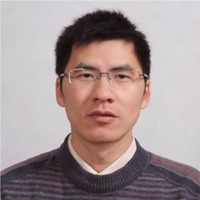- Speaker
- Prof. Hong-Jun Xiang
- Department of Physics, Fudan University
- Abstract
向红军现为复旦大学物理系教授。1997-2006年就读于中国科大,并获本科和博士学位,2006-2009年在美国北卡州立大学和美国可再生能源国家实验室开展博士后研究。他主要从事计算凝聚态物理研究。曾获2008年全国百篇优秀博士论文奖,入选2014年中组部青年拨尖人才。迄今发表论文100多篇,其中Phys. Rev. Lett. 18篇。
- About the Speaker
We proposed a unified model [1,2] which includes purely electronic and ion-displacement contribution simultaneously to describe spin-order induced ferroelectricity. On the basis of the unified model and density functional calculations, we explained the ferroelectricity induced by the proper-screw spin spiral [1], discovered a novel magnetoelectric coupling mechanism in which the magnitude of the polarization is governed by the exchange striction with the direction by the spin chirality [3], proposed that the ferroelectricity in the chiral-lattice magnet Cu2OSeO3 is due to the unusual single-spin site term [4]. Recently, we put forward a new model, i.e., anisotropic symmetric exchange, to understand the multiferroicity in LaMn3Cr4O12 and predicts that the anisotropic symmetric exchange term can be even stronger than the conventional contributions in 5d systems [5]. We predicted that hexaferrite BaFe12O19 may be the first example of multiferroic materials that displays antiferroelectricity [6]. The antiferroelectricity in this system is "geometrically frustrated" by the underlying hexagonal structure. We propose the concept of a new type of multiferroics, namely, "asymmetric multiferroic"[7]. In asymmetric multiferroics, two locally stable ferroelectric states are not symmetrically equivalent, leading to different magnetic properties between them. Finally, we predict that double perovskite Zn2FeOsO6 is a new multiferroic with properties superior to BiFeO3. First, there are strong ferroelectricity and strong ferrimagnetism at room temperature in Zn2FeOsO6. Second, the easy-plane of the spontaneous magnetization can be switched by an external electric field, evidencing the strong magnetoelectric coupling existing in this system [8].
References
[1] H. J. Xiang, E. J. Kan, Y. Zhang, M.-H. Whangbo, and X. G. Gong, Phys. Rev. Lett. 107, 157202 (2011).
[2] H. J. Xiang, P. S. Wang, M.-H. Whangbo, and X. G. Gong, Phys. Rev. B 88, 054404 (2013).
[3] X. Z. Lu, M.-H. Whangbo, Shuai Dong, X. G. Gong, and H. J. Xiang, Phys. Rev. Lett. 108, 187204 (2012).
[4] J. H. Yang, Z. L. Li, X. Z. Lu, M.-H. Whangbo, Su-Huai Wei, X. G. Gong, and H. J. Xiang, Phys. Rev. Lett. 109, 107203 (2012).
[5] J. S. Feng and H. J. Xiang, submitted to Phys. Rev.
[6] P. S. Wang and H. J. Xiang, Phys. Rev. X 4, 011035 (2014).
[7] X. Z. Lu and H. J. Xiang, Phys. Rev. B 90, 104409 (2014).
[8] P. S. Wang, W. Ren, L. Bellaiche, and H. J. Xiang, Phys. Rev. Lett. 114, 147204 (2015).
- Date&Time
- 2016-04-21 10:30 AM
- Location
- Room: A403 Meeting Room




